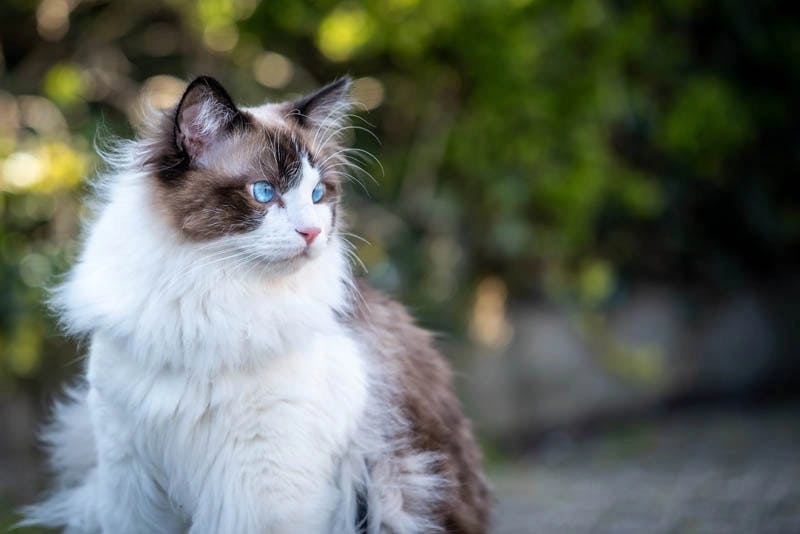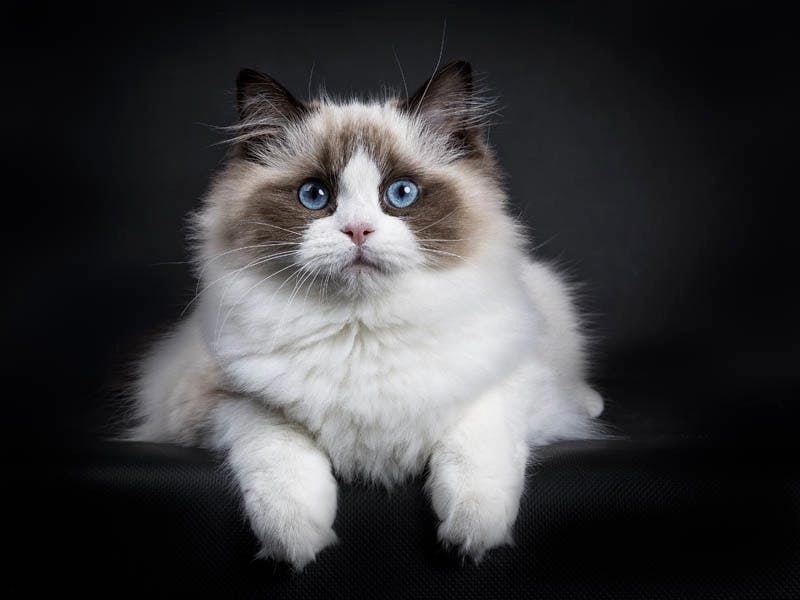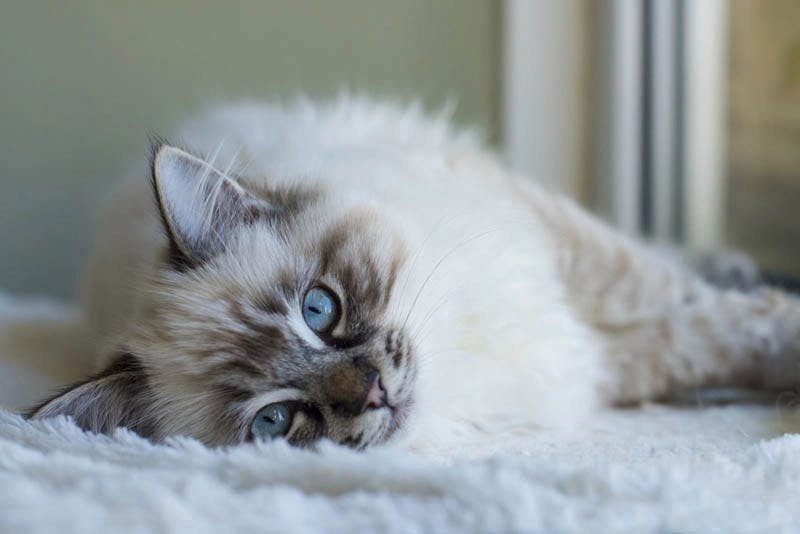Ragdoll
Unusually Large Cat with a Sweet Temperament
Ragdoll
Shane Sykes - Last updated on December 18th, 2021
All you Need to Know about the Ragdoll
Perhaps more than any other cat the "Ragdoll" is famed more for its personality than for its looks. To say this furry feline has a wonderfully easy-going, loving, and gentle nature is an understatement. They are the ultimate companion cat!
In terms of stature, this is an uncommonly big, solidly built cat. It has moderately long hair which is soft and silky to the touch. They have mesmerizing deep blue eyes and a striking colorpoint coat.
With a friendly, easy-going temperament and seemingly little fear, the Ragdoll is only suitable for indoor living as, oddly, it has no instinct to defend itself against attack.

Appearance Matters. What does a Ragdoll look like?
First things first, the Ragdoll is a big cat! That is not to say the Ragdoll is the size of a tiger, but amongst domestic cats it is considerable. They are well built, moderately long-haired, with a squarish body, and fairly short legs.
Fully grown lady cats weigh between 8 and 15 pounds typically, but the bigger boys can be anywhere from 12, up to 20 pounds. This is no lightweight feline.
All Ragdoll kittens are born a wonderful, wintry white, and slowly darken into their initial color at 8-10 weeks of age. They only reach their final adult color at 3-4 years of age. It’s a fascinating color journey!
There are many Ragdoll cat colors. And no fully grown Ragdoll cat comes in one color. They are all ‘bi-colored’ with points
What does a bicolor Ragdoll mean?
“Bi-colored” cats have ‘points’, which means in ordinary terms a darker color on the extremities, such as feet and tail, compared to the body. They also have an inverted “V” on the face, with a white abdomen, and sometimes with white patches on the back.
So while they all keep a white belly, the following ‘points’ are these…
- SEAL - the most popular
- RED
- CHOCOLATE
- BLUE
- LILAC
- CREAM
And those are just the main colors, there are ‘Lynx’ varieties and ‘Tortie’ too.
Black Ragdoll kittens are increasingly common. The only reason they are not on the list above is that they are not an officially recognized color.
Quite the color range right? But be aware that when looking for your Ragdoll kitten, it is SEAL point kittens that you will see everywhere.

It's all Personal. The Ragdoll Character
The Ragdoll is quite likely the very best breed for children and the elderly since they are slow-paced, non-aggressive, and sweet-tempered.
Many owners wax lyrical about how their Ragdoll will follow them like a second shadow. And while they may be there to meet you at the door, or watch every move you make, they do not tend to be active and annoying in trying to constantly gain your attention.
Are Ragdoll cats indoor cats?
As mentioned above the Ragdoll is a completely docile and very easygoing cat. So tranquil is it, that the breed appears to have no “fight or flight” response, and has been reported on occasion to approach fast-moving cars and vicious dogs, with very unfortunate results.
As you might guess this does not make them the most suitable for outdoor cats, and limited outdoor visits should be heavily supervised, and by someone who isn’t prone to dropping off to sleep in the backyard!
Are Ragdoll cats good with other pets?
Wondering if a Ragdoll would be okay with other pets? Then you are in luck, they are renowned for being very tolerant with other critters, and even pesky kids too. The Ragdoll has never been known to scratch, or act out at other animals.
The worst that can be ever said of a Ragdoll is that you might meet the very occasional grumpy one, but they are the unlikely exception to the rule.
Do Ragdolls meow a lot?
Along with their gentle nature, Ragdolls are also quiet cats, unlike many other breeds such as the very vocal Siamese and Bengal.
They will let their needs be known at mealtime, but they never make a lot of noise. They love to snuggle and sleep with you, but will not disturb you in your sleep. Light sleepers will love the Ragdoll!
Do Ragdolls like to be held?
By now you probably won’t be surprised by this answer! They love to be held, often for long periods of time. In fact, they will lay in your arms like a baby
But despite being cuddly, they are not clingy, and will accept a snuggle when you offer it, and not be pushy about it.
And when being picked up you are very likely to be witness to the famous Ragdoll flop...
What is the Ragdoll flop?
This is the most noticeable part of their famous, ultra chilled out, nature.
As soon as you pick up your Ragdoll, they are more likely than not to go completely limp, and their arms and legs will literally flop out. And not just for a few seconds, but right until you put them down! This really makes them the furriest baby-like cat possible.

Caring for your Ragdoll
Can Ragdoll cats be left alone?
Sorry workaholics, but this is one of the worst cats to choose if you are out all day earning the big bucks! They have a much lower tolerance for isolation than other cat breeds, especially because of their affectionate nature.
This does of course vary from cat to cat. Some cannot cope with being alone at all, but each and every Ragdoll cat will become destructive, or more likely depressed if left alone for long periods every day. And that is something none of us cat lovers like to see.
Is a Ragdoll coat High Maintenance and does it shed a lot?
Happily, the Ragdoll is a very easy breed to maintain. Once-a-week brushing is quite adequate, and it is often a process that cats relish.
Their coat is certainly luxuriant and lush, but it consists mainly of long guard hairs and not much undercoat, so there are little shedding and matting, making the grooming care of these cats simple and easy.
The Ragdoll is not hypoallergenic, no cat breed is, and it is about the middle of the road in terms of how they affect allergy sufferers.
How often should you bathe a Ragdoll cat?
As the Ragdoll is very much an indoor cat, they don’t get dirty, and logically it is not vital for them to be frequently bathed. Many Ragdoll owners do not bathe them at all, considering their cat’s own grooming to be enough. Plus bathing can be stressful for some cats.
If you do feel it necessary, do it just very rarely, and with lukewarm water, and sparingly. If they do happen to jump in your morning’s bowl of oats, then you might have to get that bath going!
The Health and Happiness of your kitty
This is the best news here! They are not prone to any particular genetic diseases. The only health tendency of any concern is that they are somewhat likely to develop allergies. This is because they have super-sensitive noses, and can react badly to strong scents like potpourris, for example.
So you might have to face up to it and chuck out your bowl of dried flowers!
What is the life expectancy of a Ragdoll cat?
Not ever the easiest thing to think about, so it is thankful that a Ragdoll can live a good, long life.
With an average lifespan of 15 to 18 years, the Ragdoll makes a marvelous addition to any household that wants a beautiful, relaxed, and loving feline companion. However, a word to the wise: Ragdolls are ”like potato chips” – it is hard to have just one!
Feline History. Where does the Ragdoll come from?
The Ragdoll originated in sunny California in the 1960s, thanks to a woman named Ann Baker and a regular, non-pedigreed, Angora-type long-haired white cat named Josephine. Don’t worry this cat isn’t half-human, that ain’t what we are saying!
This cat was later injured, thankfully not too badly, and after healing, Josephine produced litters that were fathered by several unidentified "Birman" cats. Both Josephine and her kittens had a more gentle and relaxed nature and a few of the kittens even had a Siamese style of color.
Even more remarkably Josephine did not seem to feel any pain! Thus by accident was the Ragdoll cat, and its unique attributes, born.
Where do Ragdoll cats get their name from?
Ragdoll cats get their name from their amazing ability to go completely limp, just like a child’s rag doll! Obvious now isn’t it!
They truly have the uncanny ability, seemingly automatic, to conform to the shape of small spaces they happen to be in, such as boxes, bags, and banjo cases, and sometimes in the most unlikely of postures.
However, Ann Baker took an unusual approach to establish the name ”Ragdoll.”
Instead of registering it with the traditional cat breeding associations, she trademarked the name, set up her own registry – the International Ragdoll Cat Association (IRCA) – and enforced very strict standards for anyone who wanted to breed and sell cats under the name of Ragdoll.
Today, the Ragdoll is accepted by all major cat registries, and beloved by a stupendous amount of families.
Questions people often ask about Ragdoll kittens.
+Is the Ragdoll affectionate?
+Do Ragdolls meow a lot?
+Can Ragdoll cats go outside?
+How Expensive is a Ragdoll?
